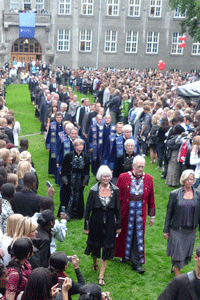Brains from abroad
(21.10.05, 08:36) They come from all around the world. They are PhD students, post-docs and researchers, offering their intellectual abilities for the benefits of NTNU. But who are they, NTNU’s international scientists?
| FAKTA | NEW SERIES
In the coming weeks, Universitetsavisa will profile some of NTNU’s international research scientists. They will tell us what they think of the university, Norway and Trondheim. | There are currently approximately 450 foreign scientists working at NTNU. During the next few weeks we will introduce our readers to the resourceful scientists who have chosen to share their expertise with the NTNU community while developing their skills here in Trondheim.
Universitetsavisa will profile some of the bright minds we have discovered in labs and offices on the university’s campuses. These foreign researchers are more than just interesting personalities – they expand the university’s horizons, making its research more international and innovative.
Aim to climb on rankings
"Our goal is to attract and recruit more scientific personnel from other countries, but we still have a job to do", says NTNU’s 2004 Annual Report for the year 2004.
NTNU's official publications leave no doubt about the university’s desire to gain more human capital of a foreign currency. The globalization of knowledge makes this imperative for an institution that aims to boost its international ranking.
No statistics at NTNU
It turned out to be difficult to actually find out how many of NTNU’s brains are from abroad. Neither the International Section nor the university administration could answer our query about this matter. A telephone call to The Research Council of Norway led us to NIFU STEP, which provided us the overall percentage of foreign scientific workers at Norwegian institutions of higher education in Norway. Although the figures date from 2001, it is reasonable to assume that the relative numbers are about the same today.
How we came up with a number
An estimated 16.000 people work in scientific positions in Norway’s institutions of higher education; of these, 15 per cent have their citizenship from countries other than Norway. If we include those with Norwegian citizenship but who were born outside of the country, this number increases to 17 per cent. Last year, there were 4.700 employees at NTNU. Six out of ten hold academic positions. Therefore we assume that there are approximately 450 people constitute at NTNU who fall under the category we will call brains from abroad.
This week we chat with Christian Suau from the Faculty of Architecture and Fine Arts.
By Kenneth Stoltz | 
